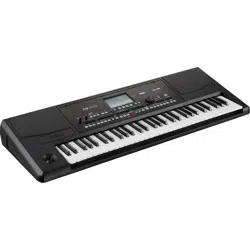Loading ...
Loading ...
Loading ...

101
Style Play
Effects: Master 1, 2
Reference
Effects: Master 1, 2
These pages contain the editing parameters for the four effect
processors. Here is an example of the FX A page, with the Reverb
Wet P late effe ct assi gned.
Selected effect
Select one of the available effects from this pop-up menu.
FX parameters
Parameters may be different, depending on the selected effect.
See the relevant chapter in the Appendix for a list of the available
parameters for each effect type.
Wet/Dry
Use this parameter to set the amount of the effect (Wet) against
the non-effected (Dry) signal coming from the track.
Src (Source)
Modulation source. To select the track generating this message,
see the “M.T. (Modulating Track)” parameters found in the
“Effects: A/B FX Configuration” page (see above). See the rele-
vant chapter in the Appendix for a list of the modulation
sources.
Track Controls: Mode
This page lets you connect each track to the internal sound gen-
erator and to external devices. This is very useful to play, for
example, a software synthesizer with one of Pa300’s Keyboard or
Style tracks. In addition, here you can set the polyphony mode
for each track.
Int./Ext. (Internal/External)
Internal The track plays the sounds generated by the
internal sound engine. It does not play an exter-
nal (hardware or software) instrument connected
to the USB Device port.
External The track plays an external (hardware or soft-
ware) instrument connected to the USB Device
port. The connected device must receive on the
MIDI channel associated with this track on the
Pa300 (see “MIDI: MIDI Out Channels” on
page 160).
A track set to this status cannot play the internal
sounds.
Instead of the assigned Sound name, the
<E: aaa.bbb.ccc> indicator is shown on a track’s
area in the Main page:
This indicator begins with a remark saying the
track is in External (”E”) mode, and continues
with a strings of transmitted Control Change and
Program Change data. This will let you know
what the track is transmitting to the USB Device
port. In the following example, CC#0 is the Con-
trol Change 0 (Bank Select MSB), CC#32 is the
Control Change 32 (Bank Select LSB), PC is the
Program Change:
When touching the Sound area, the numeric key-
pad appears, instead of the Sound Select window.
You can enter the Control Change/Program
Selected effect
FX parameters
FX group
Control Change/Program Change area
CC#0 value
CC#32 value
PC value
Loading ...
Loading ...
Loading ...
